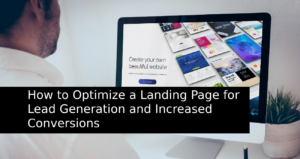Making your business accessible for all is a smart move. Not only is it legally required in many cases, but it also makes your business available for a wider audience.
If your business isn’t accessible, it means you’re shutting out some people who could be prepared to spend money with you. You need to consider how to make your business accessible for disabled people so that you are not blocking anyone from accessing your products or services for discriminatory reasons.
To make your business accessible, you should be following the regulations set out by the ADA, and in some cases even going what is required.
When it comes to websites, you may wonder whether they also need to be designed so that they are accessible and follow the ADA. The answer is a little more complicated than you might think.
What is ADA?
The ADA is the Americans with Disabilities Act. This set of regulations was created to make businesses and public services accessible for disabled people. It sets out laws that businesses need to follow to make their businesses accessible for people with a range of disabilities and impairments.
This can include making a store wheelchair accessible or navigable for people with mobility issues. It can also include making products and services accessible for people who are deaf or blind.
There are many different ways businesses are expected to take people’s varying needs into account and ensure that no one is prevented from accessing their products and services.
Do Websites Need to Comply with the ADA?
When it comes to websites, they are one of the ways that people can interact with your business.
If a business does not comply with the ADA or make its business accessible, it can be left open to lawsuits. This is evident in the rise in lawsuits relating to website accessibility, which increased 177% between 2017 and 2018.
However, the Americans with Disabilities Act Title III, which relates to public businesses, does not address websites directly. Although local and state government websites are required to be accessible, no such requirement exists for public businesses.
But, although there is no clear legislation requiring websites to be ADA compliant, there have been many lawsuits concerning inaccessible websites for businesses.
Additionally, some businesses have been ordered by the court to make their website accessible. Therefore, it is really in the best interest of any business owner to ensure they have a website that is accessible to everyone.
The Lack of Clarity Concerning Websites and the ADA
The ADA is clear that brick-and-mortar businesses need to be accessible to people with disabilities. This means that public-facing businesses need to take a range of measures to ensure accessibility, from training their staff to creating the right physical environment.
However, because the ADA doesn’t address websites that are available to the public, it’s unclear whether websites are required by law to be accessible in the same way.
The ADA was first created in 1990, which was a good few years before websites were widely used and every business was expected to have one. Although it has been updated since it still does not directly address websites.
Will There Be Clarification on Websites and the ADA?
There have been a couple of occasions when it looked like websites could be addressed in official regulations. In 2016, the DOJ considered addressing website accessibility directly.
However, this didn’t happen and there was no clarification from the DOJ. A case on web accessibility almost made its way to the Supreme Court in 2019.
A 2016 civil suit against Dominos Pizza eventually led to Dominos appealing to the Supreme Court. Although the case was declined and returned to the lower court, the ruling in favor of the plaintiff supports the idea of website accessibility being legally required.
What Might Happen If Your Website Isn’t Accessible for Disabled People?
Although there might not be clearly written legislation on website accessibility, there could still be consequences if you don’t make your website accessible to all.
First of all, you could be in danger of a lawsuit if your website isn’t accessible for disabled people. Regardless of whether you win the case or not, having to face it is likely to be time-consuming and expensive.
If you lose, you could also find that you are ordered to make your site accessible, in addition to paying the plaintiff’s fees in some cases.
Additionally, an inaccessible website could affect your business’s reputation and cause people to choose other businesses. Instead of that happening, you could simply make your site accessible, to begin with.
What Does It Mean for a Website to Be Accessible?
What exactly is an accessible website? How can you make sure that as many people as possible are able to use your site? It can be difficult to make a website accessible for every single person, especially because some people have competing needs that require opposite accommodations. However, there are plenty of things that you can do to make your site more accessible.
There are multiple types of disability to keep in mind when designing an accessible site. People may be blind or visually impaired, deaf or hard of hearing, have cognitive disabilities, neurological disabilities, or speech or physical disabilities. This may seem like a lot to think about, but there are multiple changes you can make to your site (or implement in a new site) that will help people with all kinds of disabilities to access it.
An accessible site should provide options to change the functionality of the site and have accessibility built into the site in multiple ways too. Just a few things to consider include people who use screen readers, people who can’t hear or process audio, dyslexic people, and people who might not be able to navigate your site using a mouse.
How Can You Make Your Website ADA Compliant?
You can make your site accessible and ADA compliant in many ways. If you’re designing or updating your website, you can make a number of good choices. Additionally, there are some ongoing things to pay attention to when you publish new pages or content. For example, you should make sure all videos have subtitles and/or a transcript. It’s a good idea to work with a web design service like WebX360 to help you design a custom site that’s accessible for all.
-
Offer a Choice of Font Sizes
One of the simplest things that you can do with your website is to allow the user to change the font size. If you have a WordPress site, there are some plugins that can make it easy to do this. This can help many people, including those who are blind or visually impaired and people who are dyslexic or have other learning or cognitive disabilities.
-
Use Alt Text for Images
Images might make your site look good, but they’re not necessarily useful for blind or visually impaired people. Some people may see more than others, but for many people, it could be unclear what your images are or even if there is an image at all. This is where alt text for images comes in. You might have been advised to use alt text for SEO, but it’s also there for accessibility, allowing you to describe key images.
-
Consider Screen Readers and Braille Readers When Writing Content
Screen readers and Braille readers will read image descriptions to users. However, there are other things to consider when keeping this technology in mind. One thing to remember is that it’s a good idea not to put anything unnecessary into your text. For example, a row of emojis or asterisks will be read out one by one by a screen reader, which is a waste of the user’s time.
-
Choose the Right Colors and Contrasts
Another visual element to consider is the colors that you use on your site and the contrasts between them. The right contrast makes it easier to read the text for people with visual, cognitive, or neurological disabilities. You can find tools that help you to check the contrast.
-
Use Subtitles and Audio Description in Videos
Videos are an engaging form of content, but many people are unable to engage with them because they are not accessible. If you want to make your videos accessible, this means having appropriate subtitles for people who are deaf or hard of hearing.
A transcript provides an alternative but is less effective. For visually disabled people, audio description makes videos more accessible when there is an important action that they should be aware of.
-
Include Transcripts for Audio (Such as Podcasts)
If you have audio content, such as podcasts, offer a transcript as a visual alternative. This allows people who can’t listen to your audio to still benefit from it.
-
Offer the Option of Keyboard Navigation
Navigating your site can be difficult for some people, including those who are blind and visually impaired and some people who are physically disabled. Keyboard navigation allows them to navigate your site using their keys instead, which makes it possible for people to interact with your site more easily.
Although the ADA is unclear on whether businesses need to have accessible websites, it’s good for business and good for your website visitors. Make your site accessible so everyone can use it.




